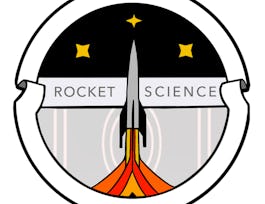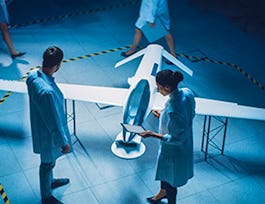The goal of this capstone spacecraft dynamics project is to employ the skills developed in the rigid body Kinematics, Kinetics and Control courses. An exciting two-spacecraft mission to Mars is considered where a primary mother craft is in communication with a daughter vehicle in another orbit. The challenges include determining the kinematics of the orbit frame and several desired reference frames, numerically simulating the attitude dynamics of the spacecraft in orbit, and implementing a feedback control that then drives different spacecraft body frames to a range of mission modes including sun pointing for power generation, nadir pointing for science gathering, mother spacecraft pointing for communication and data transfer. Finally, an integrated mission simulation is developed that implements these attitude modes and explores the resulting autonomous closed-loop performance.



Spacecraft Dynamics Capstone: Mars Mission
This course is part of Spacecraft Dynamics and Control Specialization

Instructor: Hanspeter Schaub
Sponsored by Louisiana Workforce Commission
5,271 already enrolled
(49 reviews)
What you'll learn
Apply three-dimensional kinematics to create a mission-related orbit simulation and evaluate orbit frame orientation
Utilize knowledge of rigid body kinematics to determine attitude reference frames for different attitude pointing modes
Demonstrate the ability to numerically simulate spacecraft attitude dynamics and evaluate control performance
Details to know

Add to your LinkedIn profile
11 assignments
See how employees at top companies are mastering in-demand skills

Build your subject-matter expertise
- Learn new concepts from industry experts
- Gain a foundational understanding of a subject or tool
- Develop job-relevant skills with hands-on projects
- Earn a shareable career certificate


Earn a career certificate
Add this credential to your LinkedIn profile, resume, or CV
Share it on social media and in your performance review

There are 5 modules in this course
The goal of this capstone spacecraft dynamics project is to employ the skills developed in the rigid body kinematics, kinetics and control courses. An exciting two-spacecraft mission to Mars is considered where a primary mother craft is in communication with a daughter vehicle in another orbit. The challenges include determining the kinematics of the orbit frame and several desired reference frames, numerically simulating the attitude dynamics of the spacecraft in orbit, and implementing a feedback control that then drives different spacecraft body frames to a range of mission modes including sun pointing for power generation, nadir pointing for science gathering, mother spacecraft pointing for communication and data transfer. Finally, an integrated mission simulation is developed that implements these attitude modes and explores the resulting autonomous closed-loop performance.
What's included
2 videos1 reading1 programming assignment
Tasks 1 and 2 use three-dimensional kinematics to create the mission related orbit simulation and the associated orbit frames. The introductory step ensures the satellite is undergoing the correct motion, and that the orbit frame orientation relative to the planet is being properly evaluated.
What's included
2 assignments2 programming assignments
Tasks 3 through 5 create the required attitude reference frame for the three attitude pointing modes called sun-pointing, nadir-pointing and GMO-pointing. The reference attitude frame is a critical component to ensure the feedback control drives the satellite to the desired orientation. The control employed remains the same for all three pointing modes, but the performance is different because different attitude reference frames are employed.
What's included
3 assignments3 programming assignments
Tasks 6 through 7 create simulation routines to first evaluate the attitude tracking error between a body-fixed frame and a particular reference frame of the current attitude mode. Next the inertial attitude dynamics is evaluated through a numerical simulation to be able to numerically analyze the control performance.
What's included
2 assignments2 programming assignments
Tasks 8-11 simulate the closed-loop attitude performance for the three attitude modes. Tasks 8 through 10 first simulate a single attitude at a time, while tasks 11 develops a comprehensive attitude mission simulation which considers the attitude modes switching autonomously as a function of the spacecraft location relative to the planet. Please note that the time it will take you to complete this module and the requisite tasks has increased from prior modules.
What's included
4 videos4 assignments4 programming assignments
Instructor

Offered by
Why people choose Coursera for their career




Learner reviews
49 reviews
- 5 stars
75.51%
- 4 stars
16.32%
- 3 stars
4.08%
- 2 stars
0%
- 1 star
4.08%
Showing 3 of 49
Reviewed on Jun 1, 2021
Excellent, comprehensive review of the course - kinetics, kinematics, and control but I removed a star due to the tight tolerances in the answers. I was off by exactly 0.001 and it was marked wrong.
Reviewed on Apr 17, 2022
Great application of the knowledge obtained through the course
Reviewed on May 24, 2024
Very practical and fun! Useful for those who wants to pursue a career in AOCS/GNC engineer or just a brush-up.
Recommended if you're interested in Physical Science and Engineering

SkillUp EdTech

University of Michigan

Università di Napoli Federico II

University of Colorado Boulder

Open new doors with Coursera Plus
Unlimited access to 10,000+ world-class courses, hands-on projects, and job-ready certificate programs - all included in your subscription
Advance your career with an online degree
Earn a degree from world-class universities - 100% online
Join over 3,400 global companies that choose Coursera for Business
Upskill your employees to excel in the digital economy


